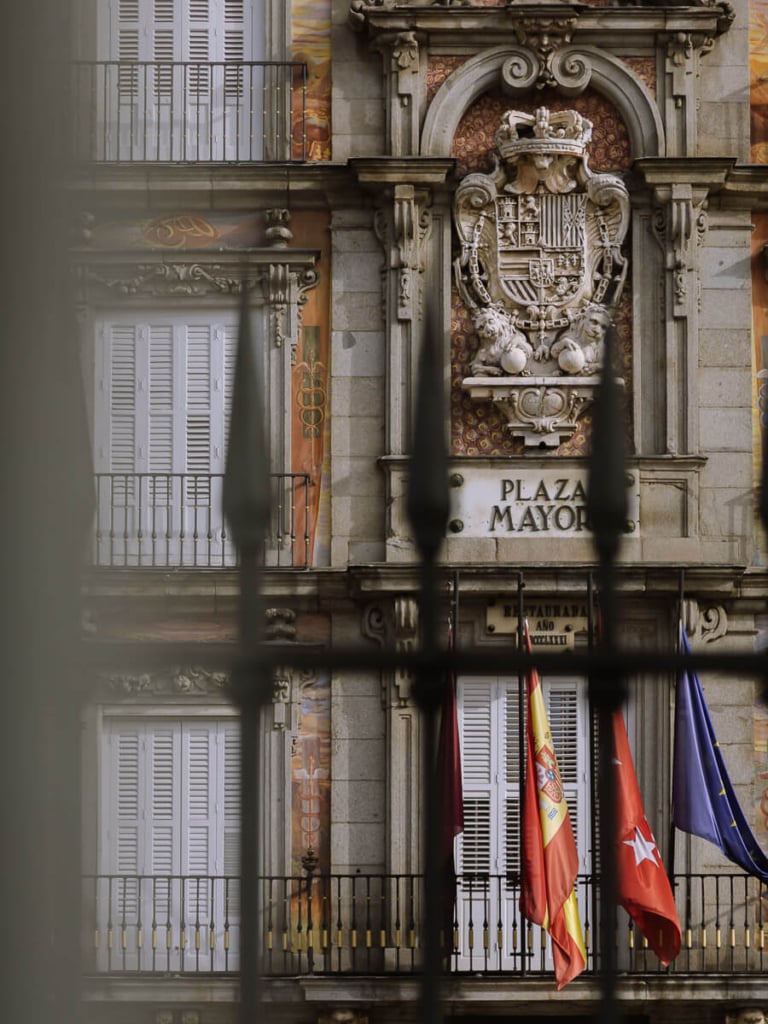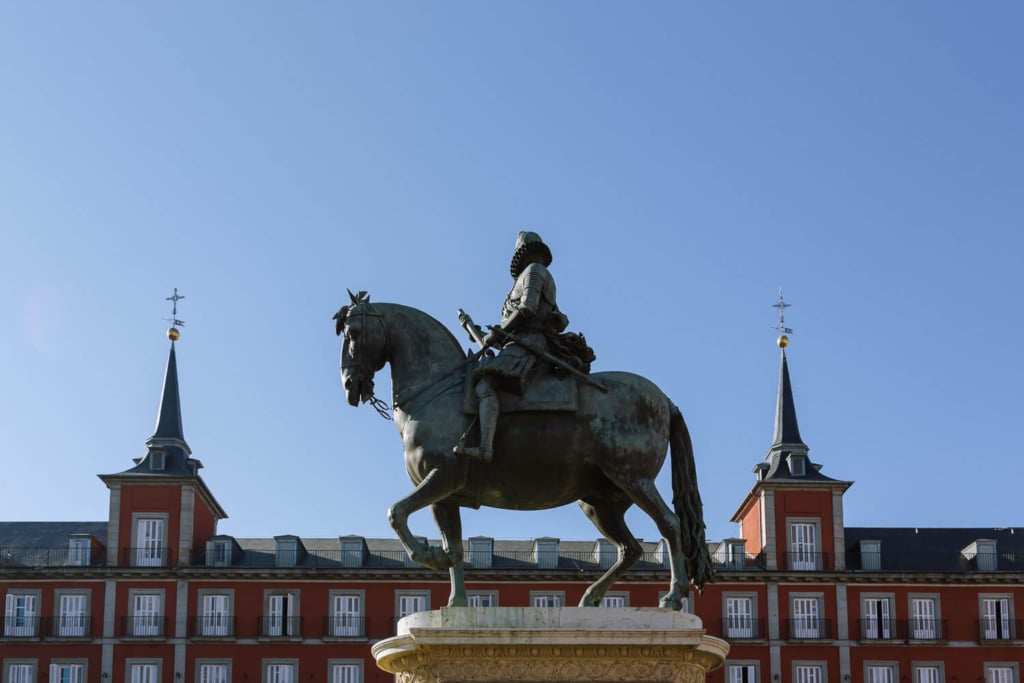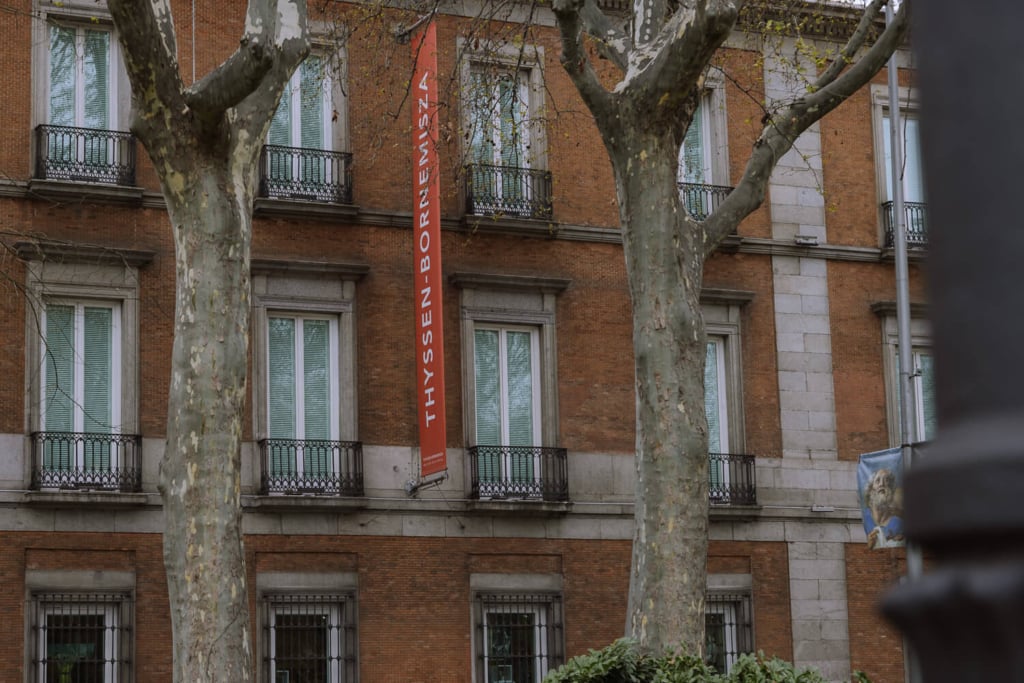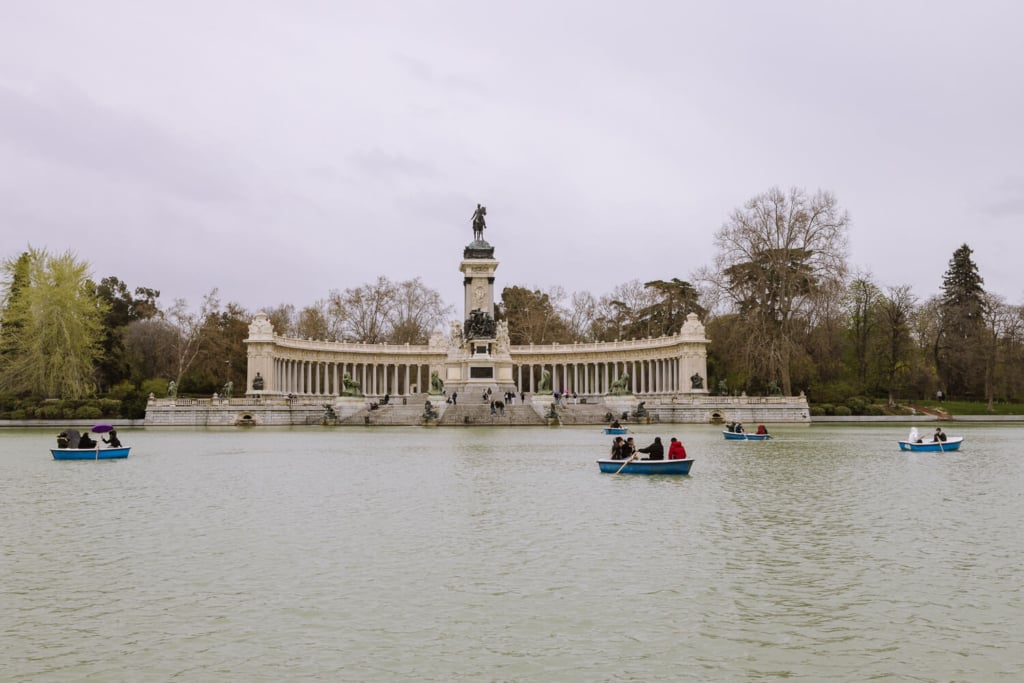
As a major cultural capital of Europe, Madrid has its fair share of world-class attractions. But beneath the regal exterior is a liveable city and a great place to hang out. Here’s our guide to the best things to do in Madrid.
Since 1561, when Felipe II moved the seat of government to Madrid, successive monarchs have constructed majestic landmarks befitting an important European capital.
From the grandeur of the Royal Palace to the magnificence of the cavernous cathedral; from the elegance of the Grand Vía to the splendour of Plaza Mayor, Madrid is a city that is dressed to impress.
While Madrid may not hold the medieval historical significance of Seville or Granada, Spain’s monarchs were passionate collectors of art, and few cities are better endowed with masterpieces than Madrid.
Beyond the city’s royal spoils and grandeur, Madrid is a great place to hang out. With its stellar gastronomic scene, cool neighbourhoods, ample green spaces, and some of the best nightlife in Europe, Madrid is a truly liveable capital.
Take a stroll down the charming, cobbled lanes, relax in quiet cafes, savour a vermouth.
Our guide to the best things to do in Madrid features all the top attractions, our favourite neighbourhoods, and an itinerary for spending three days exploring the cultural diversity of the capital.
Booking your trip via the links on this page (or on our book page) will earn us a small commission, at no extra cost to you. Thanks for your support – Paul & Mark.

1 – ROYAL PALACE
Madrid’s grandest building, the Palacio Real, was constructed on the orders of King Phillip V after previous buildings on the site were destroyed by fire. The palace that stands today has over 3,000 rooms and, by some sources, it’s considered the largest royal palace in Europe with a floor space of over 135,000 square feet.
The palace is the official home of the Spanish royal family and it’s bursting with art from big names such as Caravaggio, Goya and Velázquez, along with artifacts of historical importance.

HIGHLIGHTS AT THE ROYAL PALACE
The Throne Room // A richly decorated room where the king receives his audiences, the vaulted ceiling contains a fresco depicting the royal family through allegories in a work titled “The Greatness and Power of the Spanish Monarchy.”
Salón de Columnas // The beautifully decorated Hall of Columns is a ballroom that is still used for important civic events today. Don’t miss the exquisite Belgian tapestries.
Escalera Principal // The main staircase forms acts as an imposing entrance hall to the palace. The large sculpture of Charles II on the central landing conveys all the power it’s intended to.
Gasparini Salon // One of the most beautiful rooms in the palace, the Gasparini Hall was used by Carlos III as a private dressing room.
Book tickets in advance as queues can be long.
DETAIL | ROYAL PALACE OF MADRID
hours – 10 am to 6 pm (Monday to Saturday); 10 am to 4 pm (Sunday) | price – €12 | free entry – the palace is free from 4 pm to 6 pm Monday – Thursday
BUY TICKETS



2 – LA ALMUDENA CATHEDRAL
Construction began on the Almudena Cathedral in 1883 and wasn’t completed until 1992. The large, cavernous space is unusual for a cathedral with a vivid colourful ceiling and stained glass windows featuring straight lines.
It’s lacking the charm of other European cathedrals such as the glorious Sienna Cathedral or the incredible Granada Cathedral, but it’s worth popping in for a quick look.

PARROQUIA SANTA LA REAL DE LA ALMUNDENA (CATHEDRAL CRYPT)
While the cathedral might be lacking in aesthetic appeal, the crypt certainly isn’t.
It has the same dimensions as the cathedral with 500 columns decorated with arches and elaborate reliefs. The effect of rows and rows of columns, lit from below, is mesmerising.
The crypt also has 5 naves, 20 chapels, and beautiful Gothic-style-stained glass windows. Slightly hidden from the main cathedral it’s often overlooked but an essential thing to do in Madrid.
How to find the Crypt — The entrance to the crypt is located on the south side of the cathedral on Calle Mayor.
DETAILS | LA ALMUDENA CATHEDRAL & CRYPT
hours – 10 am to 2 pm; 4:30 pm to 8 pm (Monday – Friday); 10 am to 8 pm (Saturday – Sunday) | price – free | audio guide – €1.50



3 – PLAZA MAYOR
Plaza Mayor, Madrid’s grand central square, is the oldest part of the city and the perfect central landmark to orient yourself when exploring the city.
The square was destroyed by fire in 1790 and the current design utilises architectural uniformity to create a consistently grand space.
Cafes overlook the square from shaded porticos and, as a tourist hub, plenty of souvenirs are on sale. You’ll also find street performers, artists and at various times, outdoor concerts, and parades.
The highlights are the Arco de Cuchilleros – the most monumental of the 9 arches leading to the square and the Statue of Philip III by Flemish sculptor Giambologna.




4 – SAN MIGUEL MARKET
The San Miguel Market is a beautiful cast-iron structure dating back to 1916. After several reincarnations, today it is a centrally located shrine to Spanish cuisine and one of the best things to do in Madrid.
Most recently relaunched in 2018, the market includes the finest produce from across Spain, prepared by internationally renowned chefs. Find everything from quirky tapas to the freshest seafood, with ice cream, paella, Spanish cheese, artisanal breads and everything in between.
It can get very busy at lunch so make sure you source a table before heading to the stalls to order food.
Chocolate Fix — Nearby tiny streets conceal hidden delicacies. Don’t miss Chocolala Belga on Calle del Bonetillo, where an elderly gentleman craft incredible homemade chocolates.
DETAILS | SAN MIGUEL MARKET
hours – 10 am to midnight (Sunday to Thursday); 10 am to 1 am (Friday & Saturday)




5 – TEMPLE OF DEBOD & PLAZA DE ESPAÑA
The Temple of Debod is an ancient Egyptian temple that was dismantled and rebuilt in Parque de la Montaña, Madrid. It was donated by the Egyptian government to preserve it and it’s one of the few examples of Egyptian architecture that can be seen outside the country.
Its position surrounded by a pool of water with views over the palace make it a nice photo opportunity and a worthy attraction to check out in Madrid.
The nearby Plaza de España has recently been renovated to create a greener, more accessible tourist attraction within the city. The revamped space is now car-free with walking and cycling tracks that connect it to other green spaces in Madrid.



WE’D LOVE YOUR SUPPORT
If you found this guide useful, a small donation helps fund our work – Big thanks, Paul & Mark.
FOLLOW US ON INSTAGRAM
USE OUR RESOURCES PAGE
6 – ERMITA DE SAN ANTONIO DE FLORIDA
The Chapel of St Anthony of La Florida is a small but beautiful chapel in the centre of Madrid, known for its stunning frescoes by Francisco Goya.
Goya is considered one of Spain’s most important artists from the late 18th and early 19th centuries, with his work reflecting historical and political upheavals. He is buried in the church which acts as a fitting canvas for some of his finest works.
As a single room housing world-class art in an unassuming building, it’s one of the most underrated things to do in Madrid.
DETAILS | ERMITA DE SAN ANTONIO DE LA FLORIDA
hours – 9:30 am to 8 pm (Tuesday – Sunday), closed Monday | price – free

7 – MALASAÑA DISTRICT
Malasaña is a bohemian district in Madrid with cool shops, restaurants, cafes, bars and markets. The best way to experience it is to stroll around aimlessly soaking up the ambiance.
The ground floors of the buildings are reserved for an assortment of retail outlets including tattooists, bakeries, fishmongers, boutiques and bars, while upstairs is reserved for residential accommodation. The result is a lived-in area, slightly worn around the edges and bursting with character.
Here are some of our favourite places in Malasańa –
HanSo Café // A relaxed coffee house with a great selection of sandwiches and excellent coffee.
Plaza Juan Pujol // Colourful square with student-centered cafes and street art, it’s a cool place to hang-out when you need a break.
Toma Café // Great little café for specialty coffee, cakes and pastries, and one of the best tomato and bread in Madrid.




8 – GRAN VÍA
Madrid’s most famous street, Gran Vía, was built between 1910 and 1929 and required the demolition of over 300 buildings to create the regal boulevard it is today.
Referred to as the Spanish Broadway, Gran Vía is the centre of nightlight in Madrid with the city’s main concentration of cinemas, theatres and restaurants.
After a revamp in 2018, Gran Vía now has more green spaces, wider pavements and a bike lane between Callao and Plaza de España. It’s the perfect place for window shopping, bar hopping and aimless ambling in an iconic setting.
Some of the iconic landmarks on Gran Vía include Metrópolis, Telefónica Bulding, Casino, and the Capital Building.


9 – THYSSEN-BORNEMISZA NATIONAL MUSEUM
Madrid is a hotbed of European art. There are three magnificent world-class galleries to explore. The Thyssen-Bornemisza National Museum, with a vast collection of works from the Middle Ages through to the late 20th century, has the broadest range.
Explore the major art movements including Renaissance, Mannerism, Baroque, and Rococo, through to Expressionism and 20th-century Pop Art. The collection also has a large display of 19th-century American paintings, rarely found in European galleries.
Some of the more recognisable pieces come from Caravaggio, Rubens, Dalí, Monet, Rembrandt, Picasso, and Lichtenstein. But, the Thyssen-Bornemisza Museum includes plenty of less-known masterpieces and it’s worth a few hours strolling around.


Why go? — The Thyssen-Bornemisza National Museum is great for getting a broad overview with some of the best art from different periods across the world.
Audio Guide – Beyond the artist and title, there is no labelling on the works, so it’s a good idea to take the audioguide. Starting from the top floor and working down, the audioguide provides an engrossing walk through the museum and takes around 3 hours. The audio guide is €5 over the ticket price.
DETAILS | THYSSEN-BORNEMISZA NATIONAL MUSEUM
hours – 12 pm to 4 pm (Monday); 10 am to 7 pm (Tuesday); temporary exhibitions differ so check their website – museothyssen.org | prices – €13 (general); €9 (discounts); The museum is free on Mondays.
BUY TICKETS

10 – PRADO MUSEUM
The Prado Museum is the main Spanish national art museum containing the world’s most comprehensive collection of Spanish painting. With a collection of around 20,000 works from the 12th to the 13th century, the Prado is widely considered to be the finest collection of European art in the world.
The collection includes the most complete works of El Greco, Velázquez and Francisco de Goya as well as important masters including Zurbarán, Raphael, Tintoretto, and Peter Paul Rubens to name just a few.
Why go? — The Prado Museum is the best gallery in Madrid for seeing the best of the traditional Spanish masterpieces.

HIGHLIGHTS AT THE PRADO MUSEUM
- Room 16 – Murillo fuses of the celestial and everyday in room 16. “The Apparition of the Virgin to saint Ildephonus” divides the upper divine world with the lower early in beautiful detail.
- Room 46 – The Holy Family or “La Perla” by Raphael was the favourite work in Philip IV’s collection and it’s easy to see why, the emphasis on light is stunning.
- Room 75 – The sheer scale of the works in room 75 are breathtaking, particularly Sisyphus by Titian.
- Rooms 67 – The 14 “Black Paintings’ by Goya are on permanent display in room 67. Depicting haunting themes, they reflect his bleak outlook on humanity and were originally painted directly on the walls of his house.
- Room 78 – The Prado has 90 Rubens in the collection. “The Judgement of Paris” in room 78 was influenced by his time in Italy with figures based on classical sculptures.
DETAILS | PRADO MUSUM
hours – 10 am to 8 pm (Monday – Saturday); 10 am to 7 pm (Sundays) | price – €10/€7.50; free for under 18-year-olds or students between 18 and 25.
BOOK TICKETS


11 – REINA SOFIA MUSEUM
The Museo Nacional Centro de Arte Reina Sofía is the national Spanish museum for 20th-century art featuring contemporary works from some of the country’s leading artists. Opening in 1990, the museum was considered an important step in Spain’s transition to democracy.
The most famous work is Guernica, the colossal piece by Malaga-born artist Pablo Picasso depicting the suffering experienced during the Spanish Civil War.
Their other prized possession is The Great Masturbator, the psychic snapshot of life as seen by a 25-year-old Salvador Dalí.
It’s a massive collection with interesting temporary exhibitions and installations in addition to the permanent collection.
DETAILS | REINA SOFIA MUSEUM
hours – 10 am to 9 pm (Mon, Wed, Thu, Fri, Sat); 10 am to 2:30 pm (Sunday); Closed Tuesday | cost – 12 | free admission – the museum is free from 7 pm to 9 pm weekdays and Saturday, and 12:30 pm to 2:30pm Sunday.




TIP // ART WALK PASS
If you plan on visiting all three major art galleries (Thyssen-Bornemisza, Prado and Sofia Reina) buy the Art Walk Pass which is €32 and includes skip-the-line access to all 3 galleries. Tickets must be picked up from the gallery you purchase the pass from.
12 – RETIRO PARK
Spread over 125 hectares in central Madrid, El Retiro Park is a green oasis in the centre of the city. Recently named a UNESCO World Heritage Site, the park is a popular destination for unwinding in Madrid with grassy fields, open-air cafes, tree-lined pathways, and romantic gardens.
There are a variety of landscape styles on display as well as ornate statues and dreamy fountains. Here are some of the attractions –
- Estranque – The large artificial lake is the central focus of Retiro where you can hire a rowboat to take in slow Madrid life.
- Monument to King Alfonso XII – The massive monument beside the lake is dedicated to Spain’s favourite monarch. On the weekends, you’ll find musicians gathered on the steps.
- Palacio de Cristal – The famous glass palace is an architectural masterpiece magnificently reflecting in the small lake surrounding it. The building was constructed in 1887 to house exotic plans for an exhibition from the Philippines.
- Palacio de Velázquez – Located beside the crystal palace, The Velázquez Palace is an exhibition space featuring displays from the Reina Sofia collection.
- El Angel Caído – The Fallen Angel statue is a sinister work featuring the moment Lucifer is cast out of heaven. The work by sculptor Ricardo Bellver is admired for its sense of tension and anguish.



13 – EL RASTRO FLEA MARKET
As a Sunday institution, the El Rastro Flea Market spirals out from its central hub around Plaza de Cascorro to fill the streets with treasures from over 1,000 stalls.
The main section is the triangle formed by Calle de Toledo, Calle de Embajadores and Ronda de Toledo, which primarily focuses on clothing. The side streets contain a host of treasures, and you can pretty much find everything from trading cards to vintage furniture, second-hand vinyl to obscure kitchenware.
The surrounding neighbourhood has generation-old tapas bars and creaking restaurants. Try the tiny Ruda Café for great coffee and snacks. For something more substantial, the Toastadas at El Caprichio Extremeño are a Sunday staple.




14 – BASILICA DE SAN FRANCISCO EL GRANDE
Basilica of Saint Francis the Great is a visual masterpiece and a homage to Spanish art.
Not giving much away from the exterior, inside a round floor plan crowned with a huge 33-metre dome contains marble and gold inlaid chapels, and an enviable collection of art from Spanish masters. It’s one of the most beautiful churches in the world.
There are 3 chapels featuring paintings by Zurbarán but the most famous work is the magnificent painting by Francisco Goya, St Bernardino of Siena preaching to Alfonso V of Aragon.
DETAILS | BASILICA DE SAN FRANCISCO EL GRANDE
church hours – 8 am to 10:30 am (Monday to Saturday); 10 am to 1:30 pm; 6:30 pm to 8 pm (Sunday) | museum hours – 10:30 am to 12:30 pm; 4 pm to 5:30 pm (Tuesday – Saturday) | price – €5/3 | free access – entry is free on Thursday.



15 – NIGHT IN CHUECA
Chueca is a lively neighbourhood in the heart of Madrid, known for its diversity, gay-friendly venues, cozy pavement cafes, tapas bars and vibrant street art.
It’s a great destination for a night out in Madrid with traditional Spanish restaurants and some of the best bars and clubs in town.
For dinner try either El Social or Josefita. Both pull-off the cute atmospheric tiny Spanish restaurant with great wine lists and some excellent regional dishes.


WHERE TO STAY IN MADRID
Some of the most popular areas for tourists include the city center (Sol, Gran Vía, and Opera), which is ideal for its proximity to the main attractions and nightlife.
The Malasaña neighborhood is a trendy and bohemian area with great restaurants, bars, and street art. Chueca is another popular neighborhood known for its LGBT-friendly atmosphere and lively nightlife.
For a more upscale experience, the Salamanca neighborhood is a great option with high-end shopping and dining options.
LAS LETRAS / LUXURY
GRAN HOTEL INGLÉS
The Gran Hotel Inglés is the place to go for an indulgent stay in Madrid. With Art Deco design blended with the building’s traditional character and a deluxe spa, you want wont to leave.
CENTRO / HOSTEL +
WOOHOO SUITES MADRID
Woohoo Suites has both hostel rooms and hotel suites in an excellent location just off Gran Vía. The hotel rooms and small but stylish and the hostel has rooms and dormitories with private and shared bathrooms.


MALASAÑA / FASHIONABLE
7 ISLAS HOTEL
The family-run 7 Islas Hotel is a stylish and affordable option in one of the best neighbourhoods of Madrid. Natural materials create a striking yet welcoming vibe and the amenities are first-class. Don’t skip the cocktails.
CHUECA / BOUTIQUE
PETIT PALACE CHUECA
Part of a chain of boutique hotels in Madrid, Petit Palace Chueca is a moderately priced yet chic property in a grand building near Gran Via. Some rooms have large terraces overlooking the boulevard.
HOW MANY DAYS IN MADRID
We would recommend spending at least three to four days in Madrid to get a good taste of the city’s culture, history, and gastronomy.
In this time, you can visit some of the main attractions like the Prado Museum, Retiro Park, and the Royal Palace, as well as enjoy some of the local food and nightlife. If you have more time, you can explore the city’s different neighbourhoods, visit more museums, or take day trips to nearby towns and cities.
BEST TIME TO VISIT MADRID?
Madrid is a year-round destination with plenty of things to do throughout the seasons. With a packed calendar of events, regular festivals, and a host of indoor and outdoor activities most travellers will be able to keep themselves occupied all year.
MADRID IN SPRING (MARCH TO MAY)
Spring is a beautiful time to visit Madrid when the weather is mild, and the city is in bloom. The average temperatures are around 15-20°C (59-68°F), making it perfect for outdoor activities like strolling through the city’s parks and gardens. Spring features some of Madrid’s biggest events, including the San Isidro Festival in May, which celebrates the city’s patron saint with traditional food, music, and dance.


SUMMER IN MADRID (JUNE TO AUGUST)
Summer in Madrid can be hot and dry, with temperatures often exceeding 30°C (86°F). However, this time of year is perfect for enjoying Madrid’s vibrant outdoor nightlife scene and rooftop bars. This is also the time when Madrid’s open-air cinemas and summer music festivals are in full swing, such as the Veranos de la Villa festival.
AUTUMN IN MADRID (SEPTEMBER TO NOVEMBER)
Autumn in Madrid is a beautiful season when the temperatures begin to cool down, and the city’s parks are filled with autumnal colours. The average temperatures are around 15-25°C (59-77°F), making it an ideal time for sightseeing and outdoor activities. Autumn is also a great time to enjoy Madrid’s awesome food scene, as the city’s restaurants feature seasonal dishes made with local ingredients.
WINTER IN MADRID (DECEMBER TO FEBRUARY)
Madrid’s winters are chilly and can be rainy, with average temperatures around 5-10°C (41-50°F). However, winter is perfect for enjoying Madrid’s Christmas markets and festivities, such as the famous Three Kings parade on January 6th. Madrid also has a vibrant indoor cultural scene, with many museums and theaters to visit during the colder months.

MAP | THINGS TO DO IN MADRID
Most of Madrid’s tourist attractions are located in the central district including landmarks such as the Royal Palace of Madrid, the Plaza Mayor, the Gran Vía, and the Mercado de San Miguel, as well the Prado Museum, the Reina Sofia Museum and the Thyssen-Bornemisza Museum.
Our map contains all the things to do in Madrid listed in this guide.
How to use this map / Click on the top left of the map to display the list of locations, then click on the locations to display further information. Click on the top right corner of the map to open a larger version in a new tab or the star to save to your Google Maps.

THANKS FOR VISITING // WHERE NEXT?
A BIG THANK YOU
We’ve been providing free travel content on Anywhere We Roam since 2017. If you appreciate what we do, here are some ways you can support us.
Thank you!
Paul & Mark
FOLLOW US ON INSTAGRAM
USE OUR RESOURCES PAGE



 20+ Best Things to Do on Salt Spring Island
20+ Best Things to Do on Salt Spring Island  How to get from Punta Cana to Santo Domingo: bus, Taxi, Transfer, Shuttle or rental car?
How to get from Punta Cana to Santo Domingo: bus, Taxi, Transfer, Shuttle or rental car?  Travel to Costa Brava and escape the crowds
Travel to Costa Brava and escape the crowds  The 6 Best Seattle Breweries
The 6 Best Seattle Breweries  Delicious Maltese food – where and what to eat in Malta
Delicious Maltese food – where and what to eat in Malta  Cape Town to Namibia road trip
Cape Town to Namibia road trip  Savoring a Day Yacht Charter Adventure in the Bahamas
Savoring a Day Yacht Charter Adventure in the Bahamas  Adventure Travel: Exploring the Unknown
Adventure Travel: Exploring the Unknown  How to Build a Habitable Cabin with Lumber and Tiedown Straps
How to Build a Habitable Cabin with Lumber and Tiedown Straps